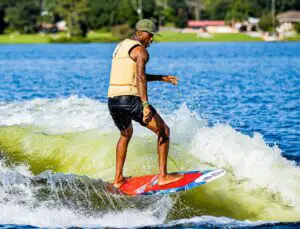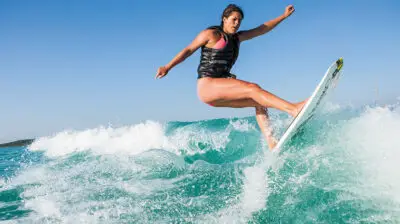Wakesurfing is a thrilling watersport that involves riding the wake of a boat or a wave with a small board. Wakesurf boards are specially designed for this purpose, with unique features that allow riders to perform tricks and maneuvers on the water. However, how big are wakesurf boards?
One of the essential factors to consider when selecting a wakesurf board is the size, which can impact the rider’s stability, speed, and overall performance. In this article, we’ll explore how big wakesurf boards are and why size matters when it comes to wakesurfing.
The different sizes and shapes of wakesurf boards

Wakesurf boards come in a variety of sizes and shapes, each with unique features that cater to different riding styles and skill levels. The three main factors that determine wakesurf board size are length, width, and thickness.
- Length:
Wakesurf board length typically ranges from 3’6” to 5’6”. Longer boards are more stable, making them ideal for beginners, while shorter boards offer greater maneuverability and are better suited for advanced riders who want to perform tricks and stunts.
- Width:
Wakesurf board width varies from around 19 inches to 24 inches. Narrower boards are easier to maneuver and provide more speed, while wider boards offer greater stability and are ideal for beginners.
- Thickness:
Wakesurf board thickness ranges from ¾” to 3”. Thicker boards offer greater buoyancy and are ideal for heavier riders or those looking for more stability.
In addition to these factors, wakesurf board shape also plays a significant role in performance. The most common shapes are surf-style and skim-style. Surf-style boards are typically longer, wider, and thicker, providing greater stability and ease of use. Skim-style boards are shorter, narrower, and thinner, making them more maneuverable and ideal for advanced riders who want to perform tricks.
It’s important to choose a wakesurf board that fits your body weight, skill level, and riding style to ensure the best possible performance and enjoyment on the water.
The importance of choosing the right size wakesurf board
Choosing the right size wakesurf board is crucial for optimal performance and enjoyment on the water. A board that is too small or too large can negatively impact your stability, speed, and maneuverability, making it difficult to ride and limiting your ability to perform tricks.
If you are a beginner, choosing a board that is too small can make it challenging to balance and stay upright, leading to frustration and a slower learning curve. On the other hand, a board that is too large can be cumbersome to maneuver, making it challenging to perform turns and other tricks.
For more experienced riders, choosing a board that is too small can limit your ability to perform advanced maneuvers and stunts, while a board that is too large can be too slow and less responsive.
Choosing the right size wakesurf board involves considering your body weight, riding style, and skill level. Heavier riders may require a larger board for greater buoyancy and stability, while lighter riders may prefer a smaller board for more maneuverability.
Riders who prefer a more relaxed, surf-style riding experience may opt for a longer, wider board, while those who enjoy a more challenging, skim-style riding experience may prefer a shorter, narrower board.
Overall, choosing the right size wakesurf board is essential for optimal performance and enjoyment on the water. A board that is well-suited to your body weight, riding style, and skill level will help you stay balanced, maneuver with ease, and perform tricks with confidence.
Factors to consider when selecting a wakesurf board size
When selecting a wakesurf board size, there are several factors to consider to ensure the best possible performance and enjoyment on the water. Here are some of the key factors to keep in mind:
- Body weight:
Your body weight is an important consideration when selecting a wakesurf board size. A board that is too small for your weight may not provide enough buoyancy, making it difficult to stay upright and ride the wake. On the other hand, a board that is too large for your weight may be too sluggish and difficult to maneuver.
- Riding style:
Your riding style also plays a significant role in selecting the right wakesurf board size. If you prefer a relaxed, surf-style riding experience, a longer, the wider board may be ideal. If you enjoy a more challenging, skim-style riding experience, a shorter, narrower board may be a better fit.
- Skill level:
Your skill level is another important consideration when selecting a wakesurf board size. If you are a beginner, a larger board may be easier to balance and ride, while more experienced riders may prefer a smaller board for greater maneuverability and the ability to perform tricks.
- Boat or wave size:
The size of the boat or wave you will be riding also affects the wakesurf board size you choose. If you are riding behind a larger boat or on a larger wave, a longer, the wider board may be better suited to provide stability and ride the wake. If you are riding behind a smaller boat or on a smaller wave, a smaller board may be easier to maneuver.
The impact of rider weight on wakesurf board size

Rider weight is a crucial factor to consider when selecting the right wakesurf board size. The weight of the rider affects the buoyancy of the board and can impact its stability and maneuverability on the water.
If a rider is too heavy for a wakesurf board, the board may not provide enough buoyancy, causing the rider to sink and making it difficult to stay upright and ride the wake. This can also cause the board to feel sluggish and slow, making it difficult to perform tricks or maneuvers.
Conversely, if a rider is too light for a wakesurf board, the board may be too buoyant and unstable, making it difficult to control and steer. This can result in a frustrating and potentially dangerous riding experience.
To determine the right wakesurf board size based on rider weight, it’s important to consider the board’s volume. Volume is a measurement of the amount of space a board occupies and is typically measured in liters.
A general rule of thumb is that a wakesurf board should have one liter of volume for every pound of the rider’s weight. For example, if a rider weighs 150 pounds, a board with a volume of 150 liters would be ideal.
How skill level affects wakesurf board size selection
When selecting a wakesurf board, the skill level of the rider is an important factor to consider. The size of the board you choose will depend on your skill level and your riding style.
For beginners, it is generally recommended to choose a larger board. A larger board will be more stable and easier to control, making it easier for a beginner to learn the basics of wakesurfing. The larger size of the board also helps to generate more speed, which is beneficial for learning how to ride the wake.
As you progress in your wakesurfing skills, you can consider moving to a smaller board. A smaller board will be more maneuverable and responsive, allowing you to perform more advanced tricks and turns. However, a smaller board will also be less stable, making it more challenging to control.
Ultimately, the size of the wakesurf board you choose will depend on your skill level, riding style, and personal preference. It is important to choose a board that you feel comfortable and confident riding and that will allow you to progress in your wakesurfing skills.
If you are unsure what size board to choose, it is always a good idea to consult with a professional wakesurf instructor or a knowledgeable salesperson at your local surf shop.
Benefits of a larger wakesurf board
When it comes to wakesurfing, choosing the right board is essential for a successful and enjoyable experience. One option to consider is a larger wakesurf board.
Here are some of the benefits of using a larger wakesurf board:
- Stability:
A larger wakesurf board will have a wider surface area, providing greater stability on the water. This makes it easier for beginners to balance and stay upright, reducing the risk of falling off the board.
- Easier to catch the wave:
A larger wakesurf board will typically have more buoyancy, making it easier to catch and ride the wave. This is especially beneficial for beginners who are still learning how to position themselves in the wake.
- Comfort:
A larger wakesurf board will generally be more comfortable to ride, as it provides a larger platform for the rider to stand on. This can be particularly beneficial for longer rides, as it reduces the strain on the rider’s legs and feet.
- Versatility:
A larger wakesurf board can be used by a wide range of riders, from beginners to more experienced surfers. It can also be used for a variety of styles, including cruising, carving, and even some basic tricks.
Advantages of a smaller wakesurf board
Wakesurfing is an exciting water sport that requires a specific type of board to ride the waves. While larger wakesurf boards offer stability and buoyancy, smaller wakesurf boards provide increased maneuverability and speed.
Here are some of the advantages of using a smaller wakesurf board:
- Increased maneuverability:
A smaller wakesurf board is more responsive and easier to maneuver in the water. This makes it ideal for experienced riders who want to perform more advanced tricks and turns.
- More control:
With a smaller wakesurf board, the rider has more control over their movements and can make quick adjustments to their position on the board. This can help to improve the overall quality of their ride and allow them to perform more complex maneuvers.
- Improved speed:
A smaller wakesurf board is typically faster than a larger board, as it generates less drag in the water. This can be beneficial for riders who want to ride at higher speeds or perform more aggressive maneuvers.
- Portability:
Smaller wakesurf boards are generally easier to transport and store than larger boards. This can be a significant advantage for riders who travel frequently or have limited storage space.
- Increased challenge:
Using a smaller wakesurf board can be more challenging and rewarding for experienced riders who are looking to push their skills to the next level. It requires greater skill and control to ride a smaller board, which can make it more satisfying for riders who enjoy a challenge. Overall, a smaller wakesurf board can provide a more dynamic and exciting riding experience for those who are up for the challenge.
How fins affect the size and performance of wakesurf boards

Fins play an important role in the performance of wakesurf boards, as they affect both the size and overall ride experience. Here’s how:
- Size:
The size of the fins can impact the overall size of the wakesurf board. Larger fins generally provide more stability and control in the water, which can be beneficial for beginners or those who prefer a more laid-back ride. Conversely, smaller fins offer less stability and control but provide greater maneuverability and speed, making them ideal for more experienced riders.
- Performance:
The fins also affect the performance of the wakesurf board, particularly in terms of maneuverability and speed. Larger fins tend to provide a more stable ride but can limit the board’s ability to make sharp turns or perform tricks. Smaller fins, on the other hand, offer greater maneuverability and speed but can be more difficult to control and require more skill to ride effectively.
- Placement:
The placement of the fins can also impact the performance of the wakesurf board. Fins placed closer to the tail of the board offer greater stability, while fins placed closer to the center of the board provide better maneuverability. Some wakesurf boards even have multiple fin setups that allow riders to adjust the placement of the fins to suit their riding style and preferences.
Overall, fins play a critical role in the size and performance of wakesurf boards. Riders should consider the size and placement of the fins when selecting a board, as well as their own skill level and riding style, in order to achieve the best possible ride experience.
The influence of board rocker on wakesurf board size
The board rocker, or the curve along the bottom of the board from nose to tail, can have an impact on the size of a wakesurf board. Here’s how:
- More rockers = shorter board:
Boards with more rockers tend to have a shorter overall length. This is because the curve of the rocker allows the board to ride higher on the water, which reduces drag and increases maneuverability. Shorter boards are generally more responsive and easier to turn, making them ideal for more experienced riders or those who want to perform tricks.
- Less rocker = longer board:
Boards with less rocker tend to be longer overall. This is because the flatter bottom allows the board to glide more smoothly on the water, which increases stability and speed. Longer boards are generally more stable and easier to ride, making them ideal for beginners or those who prefer a more laid-back riding experience.
- Hybrid rockers:
Some wakesurf boards have a hybrid rocker, which is a combination of both more and less rockers in different areas of the board. This can provide the benefits of both a shorter, more maneuverable board and a longer, more stable board.
- Personal preference:
Ultimately, the influence of the board rocker on wakesurf board size will depend on the rider’s personal preference and riding style. Some riders may prefer a shorter board with more rocker for tricks and maneuverability, while others may prefer a longer board with less rocker for stability and speed.
It’s important to consider the board rocker along with other factors, such as skill level, board shape, and fin setup when selecting a wakesurf board.
Recommended:
Conclusion
If you want to know how big are wakesurf boards, then you should get your information on this page. Wakesurf boards come in a variety of sizes, typically ranging from 4’6″ to 5’6″ in length and 19″ to 24″ in width.
The size of the board that you should choose depends on your weight, skill level, and personal preferences. A larger board will offer more stability and be easier to learn on, while a smaller board will be more maneuverable and better suited for more advanced riders.


